The growth of Saudi Arabia’s capital markets, according to international rating agency Standard & Poor’s, will be crucial in fulfilling the “Vision 2030” economic diversification agenda. It anticipates that the emergence of the local currency debt market and the issue of foreign currencies in international markets will drive a substantial expansion of the Saudi debt capital market.
In keeping with the “Vision 2030” plan, the Kingdom is making significant efforts to lessen its reliance on oil. One of the main tenets of its “Vision 2030” is the growth of the financial industry. It seeks to develop the capital market and draw in foreign organisations and individual investors to fund some of the nation’s most important projects.
A recent S&P report titled “Saudi Arabia’s Loan Market: Ready for Take Off” claims that a robust and high-quality domestic loan market is essential to the growth and transformation of the country and could help finance large-scale projects that are part of “Vision 2030”.
Huge financial institutions, equally bigger firms, and government-related organisations are likely to take the lead at first, with low-credit quality businesses likely to follow.
The report, which Economy Middle East saw, stated, “We believe that the evolution of our ratings will be similar in some developed markets – where entities with higher credit quality reach the public debt market first, and entities with lower credit ranges – although this is likely to happen at a faster pace in the case of Saudi Arabia.”
To develop Saudi capital markets, the CMA and Tadawul (the Saudi Stock Exchange) have recently launched several initiatives. These include expediting listings, making significant investments in market infrastructure, approving regulations to make it easier for foreign investors to access Saudi capital markets, putting corporate governance practices into place, and increasing transparency.
The inclusion of Saudi stocks in the MSCI Emerging Markets Index and associated indices from FTSE Russell and S&P Dow Jones in 2019 improved Saudi stocks’ international outlook.
Following Saudi Arabian Oil Company’s (Saudi Aramco) historic first public offering in 2019, several other Saudi organisations have benefited from the stock market.
The Tadawul index’s market capitalisation increased from over USD 420 billion at the end of 2015 to over USD 2.9 trillion as of June 15, 2023.
“We don’t think the banking industry alone will be able to cover funding needs given the enormous volume and long-term nature of the investments made under Vision 2030. Rather, we anticipate Saudi businesses will expand their debt-based borrowing in the capital markets, progressively restoring the nation’s financial equilibrium and expanding the country’s internal capital market,” the research stated further.
The Capital Market Authority (CMA) permitted non-resident foreign investors to make direct investments in both listed and unlisted debt instruments in 2020, according to the CMA, citing the steps taken to strengthen the debt market’s position in Saudi Arabia.
The FTSE Emerging Markets Government Bond Index will start to feature Saudi Arabian sovereign sukuk issuances denominated in local currency by FTSE Russell in 2022. To promote the trading of debt instruments in the secondary market, the CMA also said that, as of May 2023, it will no longer be paying commissions on bond trades at Tadawul or on Sukuk.
An essential part of bringing institutional money into important projects will be the issuing of foreign currency on global markets.
“But the domestic debt market will also be essential to meet the increasing financing needs that result from the vision for traditional bonds and sukuk,” the report continued, anticipating the Saudi authorities to carry out several initiatives to aid in the growth of the local currency capital market.
In this regard, it anticipates that the top businesses in the Kingdom will take the lead in creating the local currency debt market and will profit from it ahead of issuers with medium- and small-sized capital.
The growth of Saudi Arabia’s capital markets is crucial for fulfilling “Vision 2030,” and the country is making significant efforts to diversify its economy and lessen its reliance on oil. The emergence of the local currency debt market and the issue of foreign currencies in international markets will drive a substantial expansion of the Saudi debt capital market.
The CMA and Tadawul have launched several initiatives in recent years to develop Saudi capital markets, and the inclusion of Saudi stocks in the MSCI Emerging Markets Index has improved their international outlook.
With the top businesses in the Kingdom taking the lead in creating the local currency debt market, Saudi Arabia is well-positioned to expand its internal capital market and fund large-scale projects that are part of “Vision 2030.”



